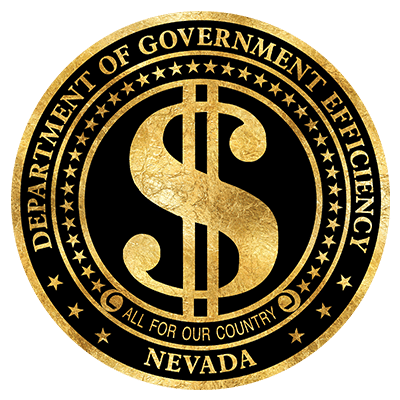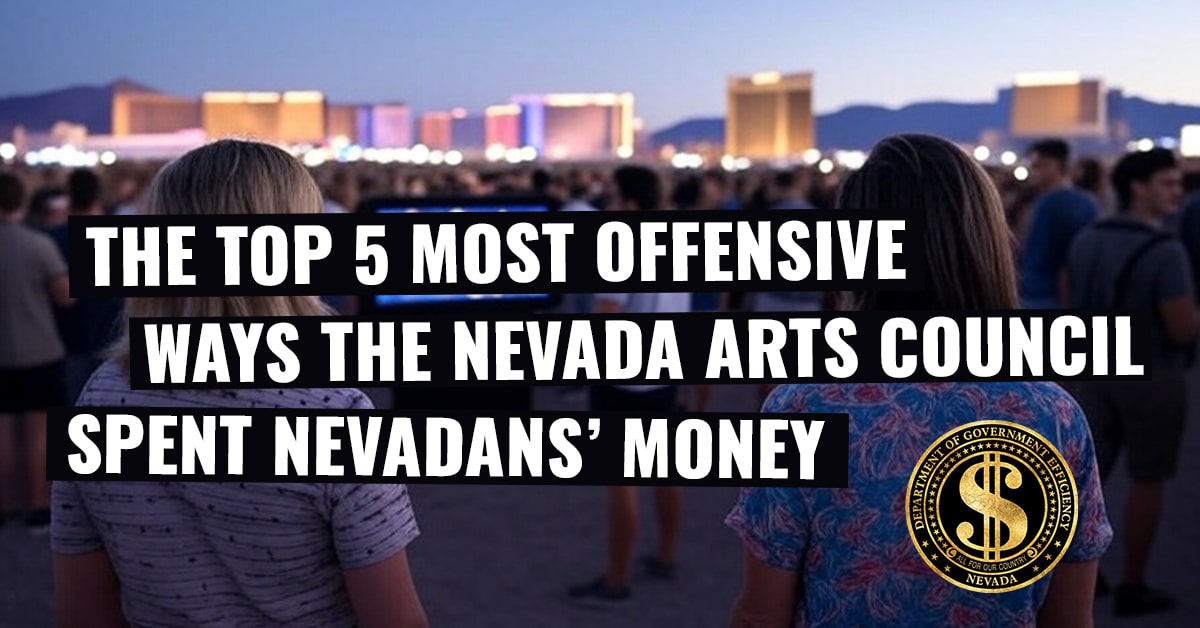This fiscal year, the Nevada Arts Council will spend nearly $3.3 million of taxpayers’ money from federal, state, and local sources. While art is undoubtedly a valuable part of Nevada’s culture, it is not the government’s responsibility to fund it. In our latest investigative report, we expose the Top 5 Most Offensive Ways Nevada Arts Council Spent Money.
Public funding of the arts raises serious concerns. When lawmakers and bureaucrats control which projects receive funding, they also gain the power to define what qualifies as art—an arrangement that risks political bias and even censorship. It assumes that the government, rather than individuals, are best equipped to decide what is artistically valuable or worthy of support.
Art, like any other good or service, should thrive in a free market. If it resonates with people, they’ll pay to experience it—whether by attending performances, purchasing books, paintings, sculptures, or other works of art, or supporting artists directly. Taxpayers shouldn’t be forced to fund art simply because a government bureacrat likes it.
The solution is simple: end government funding for the arts and let people decide for themselves what to support. That would not only preserve artistic freedom, but also leave more money in the pockets of taxpayers to support the art they truly value.
Below are five examples of how the Nevada Arts Council has used public funds to support projects that many taxpayers might find questionable, controversial, or simply not worth their money.
Nevada Women’s Film Festival
This fiscal year, the Nevada Arts Council gave $4,900 in state taxpayers’ money to the Nevada Women’s Film Festival (NWFFest) so it could screen a series of movies many Nevadans would find offensive.
In recent years, NWFFest has featured sexually explicit films, including Good Girl, a short film which explores an OBGYN’s fascination with masturbating to BDSM porn; Losing It, which follows a 30-year-old woman’s quest to lose her virginity; and Tongue in Cheek, a comedy featuring two friends creating a pop-up prostitution business focused on oral sex.
Additionally, the film fest highlighted a number of politically controversial and one-sided films at taxpayer expense. For example, 2020 Chaos and Hope shamed Americans for questioning the government’s reaction to Covid; an environmental extremist short called Ruined Earth; the anti-Trump, pro-illegal immigrant documentary Las Abogadas: Attorneys on the Front Lines of the Migrant Crisis; and Femme Rage, a short featuring “QTBIPOC Femmes, across the gender spectrum” screaming and brandishing weapons as a way to “unleash their rage about living, surviving, and thriving within a cishetero-capitalist-white supremacist-patriarchy.”
In addition to the tax dollars the Nevada Arts Council funnels to NWFFest, the UNLV-based film fest also rakes in tax dollars from the Nevada Film Office, the National Endowment for the Arts, and the National Endowment for the Humanities each year.
The Asylum (Eat More Art Vegas)
The Asylum Theatre, a project of Eat More Art Vegas, raked in $11,200 from state taxpayers over the past two fiscal years to fund a series of shows and events. While The Asylum’s programming and the East More Art Vegas website occasionally delve into politically polarizing topics, Eat More Art Vegas’ official Instagram account regularly posts divisive, partisan, extremist statements that could often be considered hate speech.
One Instagram post, for example, features the statement “Same Shit. Different Hat.” with photographs of a Ku Klux Klan hood, a Confederate soldier’s hat, a Nazi officer’s cap, and a “Make America Great Again” baseball cap.
Posts attributed to the taxpayer-subsidized organization encouraged voters to vote for Kamala Harris to “save the free world” and vote for Democrats to “defend democracy and prosperity in Nevada.” A vote for Republicans, another posts states, is a vote for “hatred, fraud, gun massacres, and rapists.”
In recent months, the Eat More Art Vegas Instagram feed has called President Trump a “megalomaniac,” ”wannabe dictator,” “convict,” “lunatic,” and less intelligent than a Chia Pet.
Other posts range from inflammatory to offensive, including calling conservatives Nazis, encouraging tourists to avoid traveling to the United States, claiming President Trump “is going to take your healthcare,” and implying Nevada Governor Joe Lombardo, who ultimately approved funding for Eat More Art, was responsible for Nevadans losing jobs.
While the content is within the organization’s right to post, it certainly raises questions about whether it is appropriate to force taxpayers to fund an organization engaged in hateful rhetoric.
Reno Punk Rock Flea Market
A bitter board dispute and some very R-rated entertainment didn’t prevent the Nevada Arts Council from sending a $4,900 handout to the Reno Punk Rock Flea Market to support a free all-ages concert series.
“The Flea,” as it’s known by supporters, is the kind of place where children smash cars with baseball bats, adults smash cars with monster trucks, and you can buy leather bondage gear and get a tattoo while listening to bands like Slutzville, Heterophobia, and Dirt Weasel.
The organization hosts two flea markets, a Punk Rock Pride event, and a Punk Prom each year, as well as supporting music therapy, animal nonprofits, low-cost music lessons, and other charitable endeavors.
Despite its good work, the Reno Punk Rock Flea Market is in disarray. Late last year, the Flea’s board attempted to expel a board member who, messages revealed, engaged in verbal abuse and bullying of others on the board. Following a contentious vote, a majority of the organization’s 11 board members resigned.
Currently, only four board members remain, according to the organization’s website.
In addition to concerns about the stability and long-term viability of the Punk Rock Flea Market, many Nevada taxpayers would find much of the entertainment featured at the Flea objectionable.
Entertainment at the Flea includes bands Pussy Velour and Grimedog playing songs such as “Kick You in the Balls,” “Suck Me Dry,” and “The Reacharound.” An upcoming all-ages event features Metalesque, a burlesque troupe that combines “the art of striptease with the raw energy of metal music,” Brianna Belladonna who eats fire and swallows swords in a bikini, and a drag show featuring the drag queen Vertigo.
Not only did the Nevada Arts Council use Nevadans’ tax dollars to support art many of them would find offensive, but the money went to an organization in shambles.
Nevada Arts Council Fellows
During the current biennium, the Nevada Arts Council awarded $5,000 fellowship grants to 18 individual artists. The grants, totaling $90,000, were awarded to Nevada artists engaged in visual, literary, or performing arts. Many recent recipients have little need for the money – earning far more than typical Nevada residents who helped to pay for their award.
For example, Frances Melhop received a $5,000 taxpayer-funded gift in 2025 for her work as a visual artist. In addition to being considered one of the best fashion photographers in the world, Melhop is known for her embroidery and printmaking, and as the owner of the Melhop Gallery º7077 in Lake Tahoe. Her works regularly sell for more than $6,000, and she owns a home on the shore of Lake Tahoe.
Ann Keniston, who won the grant in 2020 for poetry, earned $122,150 that year as a professor of English at the University of Nevada, Reno, according to Transparent Nevada. Las Vegas resident Amanda Skenandore collected $5,000 as a Nevada Arts Council fellow in the literary arts in 2024. Skenandore is a very successful novelist whose debut novel, Between Earth and Sky, won the American Library Association’s Reading List Award for Best Historical Fiction.
Linda Alterwitz has received three grants from the Nevada Arts Council, including her fellowship this year for her work superimposing x-rays, MRI scans, and thermographic images onto abstract portraits and landscapes. She regularly lectures at conferences, serves as a visiting artist at Belmont University in Nashville, and her works are in high demand by collectors and museums. Unsurprisingly, public records indicate Alterwitz lives in a house in one of the most prestigious neighborhoods in Southern Nevada valued at more than $5.5 million.
While the $5,000 prize that accompanies a Nevada Arts Council fellowship likely means little to successful artists like Melhop, Keniston, Skenadore, and Alterwitz, the money means a great deal to hard-working Nevadans struggling to keep food on the table and gas in the car.
Double Scoop Inc.
The Reno-based art blog Double Scoop pocketed $6,300 from the Nevada Arts Council in 2025 to “support Nevada arts with independent journalism.”
In April 2025, the website attracted just 1,664 visitors, according to publicly available data from Supercounters.com. The X account linked to the Double Scoop website has just 92 followers and hasn’t been updated since 2018. Double Scoop’s Facebook account hasn’t received more than nine reactions to a post since September of last year.
The paltry website visitor numbers and lack of social media engagement may have something to do with the fact that Double Scoop has largely turned its attention from artists and their work and focused, instead, on posting an increasing amount of political news and commentary.
From February 13 to May 9, six of eight Facebook posts criticized proposed federal budget cuts. Only one post was about an arts-related event. The blog’s Friday art news roundup frequently chooses to lobby for legislation rather than highlighting Nevada-based artists. Recently, the news roundup supported a scheme to redirect state general fund money to increase already questionable state arts spending by more than $1.1 million per year and championed a federal proposal to increase National Endowment for the Arts and National Endowment for the Humanities funding by a combined $418 million in the next fiscal year.
On its website, Double Scoop claims to be “a nonprofit news outlet,” but the outfit has not filed legally required nonprofit documents since 2021, according to a search of the IRS’ database of tax-exempt organizations.
Let Taxpayers Choose the Art They Value
The examples outlined in this report illustrate a fundamental problem with publicly funded art: it forces taxpayers to subsidize projects they may find offensive, irrelevant, or outright wasteful. Whether it’s sexually explicit films, politically charged performances, partisan social media content, or niche events with minimal public engagement, these expenditures reveal a troubling disconnect between what bureaucrats and arts councils deem “worthy” and what many Nevadans actually value.
Art is a deeply personal and subjective experience. What inspires one individual might alienate another. That’s why artistic expression flourishes best when driven by voluntary support rather than government mandates. Allowing taxpayers to keep more of their own money empowers them to support the art and artists that resonate with their values, beliefs, and interests—rather than being forced to fund projects selected by politically appointed panels or government agencies.


Thank you for doing the work! Please more of this.
Thanks for exposing these wasted tax dollars. Shame on any politician who greenlights this kind of waste.
To me.. the gifts to wealthy artists is the most galling!
ThePartyinNevada
Thank you for providing this eye-opening information. Voters need to know how their elected officials are spending taxpayer dollars. It’s easy to spend someone else’s money, especially if there is no accountability. Keep up the good work.